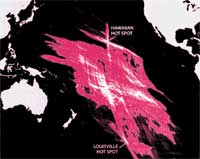Hot Spotting
 a new method presented by Paul Wessel and Loren W Kroenke at a recent meeting of the American Geophysical Union offers a way to locate hot spots under the ocean more easily and precisely than ever before ( Scientific American, Vol 276, No 4).
a new method presented by Paul Wessel and Loren W Kroenke at a recent meeting of the American Geophysical Union offers a way to locate hot spots under the ocean more easily and precisely than ever before ( Scientific American, Vol 276, No 4).
Described as hot-spotting, the technique depends on a new appreciation of some basic geometry. Previously, geologists required the age of various volcanoes created by a hot spot to determine its position. By studying the past motions of the overlying plate relative to fixed hot spots, they could trace backward along a chain of volcanoes and project to the site of rising magma. But doing so for an oceanic plate is a challenge, because ascertaining the ages of dormant, submerged volcanoes (seamounts) is plagued with difficulties
Related Content
- Order of the National Green Tribunal in the matter of Futala lake pollution, Nagpur, Maharashtra, 05/06/2025
- Order of the National Green Tribunal regarding illegal extraction of groundwater in Manakpura, Delhi by the water mafia, 13/05/2025
- Order of the National Green Tribunal regarding illegal operation of a stone crusher in village Mehli, district Sirmaur, Himachal Pradesh, 13/05/2025
- Compliance affidavit by Tahasildar, Jaleswar, District Balasore regarding sand walls being erected in Subarnarekha, Balasore, Odisha, 22/04/2025
- Asian Development Outlook- April 2025
- Order of the National Green Tribunal regarding open defecation during Maha Kumbh in Prayagraj, Uttar Pradesh, 24/02/2025
